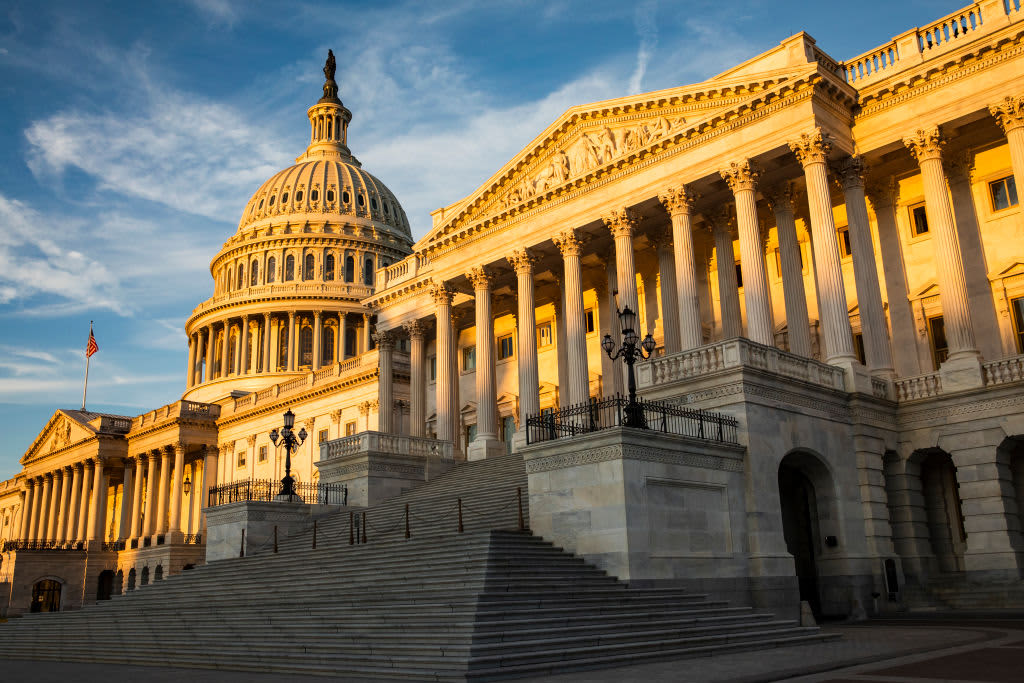Medicare beneficiaries would get dental, vision and hearing coverage if several bills now before Congress pass.
In addition, the government would get authority to negotiate prices with drugmakers and create a cap for Medicare out-of-pocket spending on prescription drugs. All have cleared the necessary committees over the last couple of weeks and now await full House action.
“There have been proposals over the years that would do this, but in the past they haven’t gone anywhere,” said David Lipschutz, associate director at the Center for Medicare Advocacy. “It looks like this time something could get passed in at least one chamber of Congress.”
The rising sun illuminates the United States Capitol Building in September in Washington, DC.
Samuel Corum | Getty Images News | Getty Images
The bills (summarized further below) are generally supported by Democrats and opposed by Republicans. This means that even if the measures get approved in the Democrat-controlled House, they would would face an uphill battle in the Republican-dominated Senate.
Roughly 10,000 baby boomers turn 65 each day and can sign up for Medicare. While the program’s 60 million beneficiaries can access dental, vision and hearing through supplemental options such as Advantage plans or standalone insurance policies, original Medicare — Part A hospital coverage and Part B outpatient coverage — excludes them except in limited circumstances.
Some of the Advantage plans now include comprehensive dental coverage as part of the plan or as an optional supplemental benefit, said Elizabeth Gavino, founder of Lewin & Gavino in New York and an independent broker and general agent for Medicare plans.
However, those benefits also might be limited to the carrier’s dental network or require prior authorization that the treatment is medically necessary, Gavino said.
H.R. 3: Includes provisions to allow the Medicare program to negotiate with drugmakers, cap out-of-pocket spending by beneficiaries on prescriptions at $2,000 and expand the low-income subsidy program, which helps cover Part D premiums and out-of-pocket costs.
H.R. 4650: Would add preventive and screening dental services, including oral exams and cleanings under Part B. It would also cover procedures such as tooth restorations and extractions, bridges, crowns, root canal treatments and implants and dentures. Beneficiaries would chip in the standard 20% for basic treatments and 50% for major treatments.
H.R. 4665: Would add routine eye exams to coverage through Part B, with beneficiaries generally paying 20% of the cost. It also would provide some coverage — $100 — toward contact lenses or eye glasses.
H.R. 4618: Would provide coverage under Part B for hearing exams and hearing aids, with beneficiaries contributing 20%.
This expanded coverage also might come with a cost. While some Advantage plans have no premium, the average is expected to be $23 in 2020, according to the Kaiser Family Foundation. Although down from $27 this year, any amount paid for a premium is on top of what Medicare enrollees pay for Part B: $135.50 is the standard for 2019 and forecast to be $144.30 next year. (Higher earners pay more).
Roughly 22.2 million, or 37%, of Medicare beneficiaries have Advantage plans. The remainder stick with original Medicare, which they can pair with a supplemental policy (i.e., Medigap) and a standalone Part D plan for prescription drug coverage (which also is typically included with Advantage plans).
“The majority of people on Medicare still choose to be in [original] Medicare, so having an expansion of benefits would accrue to everyone,” Lipschutz said. “It would be a significant improvement to the program and fill holes that have been there since its inception.”
The Congressional Budget Office has not yet released an estimate on how the three bills that expand benefits would impact Medicare’s budget. It did, however, offer a preliminary estimate of $345 billion in government savings from 2023 through 2029 if negotiating with drugmakers were allowed under the fourth bill.
More from Personal Finance:
Tips for getting your Medicare drug coverage right
Turning 100? Your birthday gift could be an unexpected tax
How to stay out of debt this holiday season
At the same time, though, the budget office report notes the bill’s negative effects may include reduced spending on research and development.
In 2018, Medicare spent about $740 billion on 59.9 million beneficiaries through its hospital, outpatient care and prescription drug benefits, according to the latest report from the program’s trustees.
Total Medicare costs are expected to rise to 5.9% of gross domestic product by 2038, up from 3.7% in 2018, the report says. The more immediate concern among opponents of the measures now headed for a possible House vote is that the trust fund for Part A (hospital coverage) is anticipated to be depleted in 2026 unless Congress acts before then. At that point, the program would be able to fund 89% of promised Part A benefits, the trustees report says.
“We are … considering four bills that expand Medicare benefits as this important program is facing bankruptcy and have no responsible way to pay for them,” said Kevin Brady, R-Texas, in his opening remarks during a hearing on the bills in a recent House Ways and Means Committee, where he is the lead Republican.
